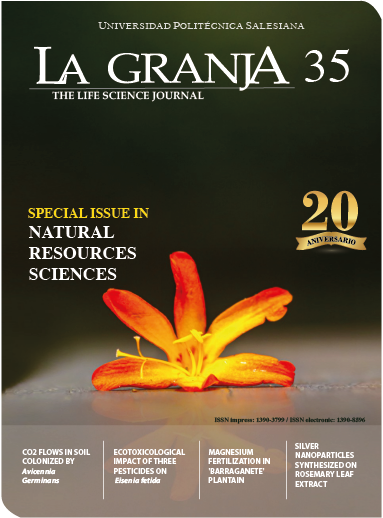Study of the oenological properties of naranjilla for gastronomy uses, Pacto-Pichincha province
Main Article Content
Abstract
Article Details

This work is licensed under a Creative Commons Attribution-NonCommercial-ShareAlike 4.0 International License.
Universidad Politécnica Salesiana of Ecuador preserves the copyrights of the published works and will favor the reuse of the works. The works are published in the electronic edition of the journal under a Creative Commons Attribution/Noncommercial-No Derivative Works 3.0 Ecuador license: works can be copied, used, disseminated, transmitted and publicly displayed.
The undersigned author partially transfers the copyrights of this work to Universidad Politécnica Salesiana of Ecuador for the printed edition.
References
Acosta, Ó., Pérez, A., and Vaillant, F. (2009). Chemical characterization, antioxidant properties, and volatile constituents of naranjilla (solanum quitoense lam.) cultivated in costa rica. Archivos latinoamericanos de nutrición, 59(1):88–94. Online: https://bit.ly/3GTQSa1.
Andrade, M., Moreno, C., Guijarro, M., and Concellón, A. (2015). Caracterización de la naranjilla (Solanum quitoense) común en tres estados de madurez. Revista Iberoamericana de Tecnología Postcosecha, 16(2):215–221. Online: https://bit.ly/3bSusHA.
Baidya, D., Chakraborty, I., and Saha, J. (2016). Table wine from tropical fruits utilizing natural yeast isolates. Journal of food science and technology, 53(3):1663–1669. Online: https://bit.ly/2ZXAGUx.
Balogu, T. and Towobola, O. (2017). Production and quality analysis of wine from honey and coconut milk blend using saccharomyces cerevisiae. Fermentation, 3(2):16. Online: https://bit.ly/3mOelRU.
Brito, B., Espin, S., Vásquez, W., Viteri, P., López, P., and Jara, J. (2012). Manejo poscosecha, características físicas y nutricionales de la naranjilla para el desarrollo de pulpas y deshidratados. Technical report, INIAP. Online: https://bit.ly/3odvjbL.
Cerón, I., Higuita, J., and Cardona, C. (2010). Capacidad antioxidante y contenido fenólico total de tres frutas cultivadas en la región andina. Vector, 5(2011):17–26. Online: https://bit.ly/3o5IlrF.
Coronel, M. (2008). Los vinos de frutas. Tesis de grado. online:https://n9.cl/7aklq, Universidad Tecnológica Equinoccial.
Dias, D., Schwan, R., Freire, E., and Serôdio, R. (2007). Elaboration of a fruit wine from cocoa (theobroma cacao l.) pulp. International journal of food science y technology, 42(3):319–329. Online: https://bit.ly/3qv32QX.
Endara, V. (2017). 600 frutas de todo el mundo se producen al noroccidente de Quito. El Telégrafo. Online: https://bit.ly/3BUOA6P.
Fracassetti, D., Bottelli, P., Corona, O., Foschino, R., and Vigentini, I. (2019). Innovative alcoholic drinks obtained by co-fermenting grape must and fruit juice. Metabolites, 9(5):86. Online: https://bit.ly/3D9b6u9.
GAD parroquial de Pacto (2012). Plan de Desarrollo y Ordenamiento Territorial del la Parroquia de Pacto 2012-2025. Online: https://bit.ly/3wz0CS1.
Gancel, A., Alter, P., Dhuique-Mayer, C., Ruales, J., and Vaillant, F. (2008). Identifying carotenoids and phenolic compounds in naranjilla (solanum quitoense lam. var. puyo hybrid), an andean fruit. Journal of agricultural and food chemistry, 56(24):11890–11899. Online: https://bit.ly/3qoglCq.
González, D., Ordóñez, L., Vanegas, P., and H., V. (2014). Cambios en las propiedades fisicoquímicas de frutos de lulo (solanum quitoense lam.) cosechados en tres grados de madurez. Acta agronómica, 63(1):11–17. Online: https://bit.ly/3bVLc0F.
Granados, C., Torrenegra, M., Acevedo, D., and Romero, P. (2013). Evaluación fisicoquímica y microbiológica del aperitivo vínico de lulo (solanum quitoense l.). Información tecnológica, 24(6):35–40. Online: https://n9.cl/wj5oh.
Guayasamín, M. (2015). Evaluación ex ante del impacto socio-económico del manejo convencional y mejorado del cultivo de naranjilla (solanum quitoense) en el ecuador. Tesis de grado. online: https://bit.ly/3odRONI, Universidad Central del Ecuador.
Ho, C., Lazim, A., Fazry, S., Hussain, U., Massa, S., and Lim, S. (2020). Alcoholic fermentation of soursop (annona muricata) juice via an alternative fermentation technique. Journal of the Science of Food and Agriculture, 100(3):1012–1021. Online: https://bit.ly/3BZ0i0a.
INEN (2016). Nte inen 374. requisitos para bebidas alcoholicas. vino de frutas. Technical report.
Joshi, V. and Attri, D. (2005). Panorma of research and development of wines in india. Journal of Scientific and Industrial Research, 64(1):9–18. Online: https://bit.ly/3bSuIq2.
Loizzo, M., Lucci, P., Núñez, O., Tundis, R., Balzano, M., Frega, N., Conte, L., Moret, S., Filatova, D., Moyano, E., and Pacetti, D. (2019). Native colombian fruits and their by-products: Phenolic profile, antioxidant activity and hypoglycaemic potential. Foods, 8(3):89. Online: https://bit.ly/3c01ohn.
Matei, F. (2017). Science and Technology of Fruit Wine Production, chapter Technical Guide for Fruit Wine Production, pages 663–703. Academic Press.
Montaner Montejano, J. (1996). Estructura del mercado turístico. Editorial Síntesis.
Ogodo, A., Ugbogu, O., Ugbogu, A., and Ezeonu, C. (2015). Production of mixed fruit (pawpaw, banana and watermelon) wine using saccharomyces cerevisiae isolated from palm wine. SpringerPlus, 4(1):1–11. Online: https://bit.ly/306CURz.
Pszczólkowski, P. and Ceppi De Lecco, C. (2016). Manual de vinificación: Guía práctica para la elaboración de vinos. Ediciones UC.
Revelo, J. and Sandoval, P. (2003). Factores que afectan la producción y productividad de la naranjilla (solanum quitoense lam.) en la región amazónica del ecuador. Technical report, INIAP. Online: https://bit.ly/3H6swde.
Romero, M. (2008). Extracción de compuestos fenólicos de la uva al vino. Papel de los enzimas de maceración. Tesis de doctorado. online: https://bit.ly/3H4to1L, Universidad de Murcia.
Swami, S.and Thakor, N. and Divate, A. (2014). Fruit wine production: a review. Journal of Food Research and Technology, 2(3):93–100. Online: https://bit.ly/3qn0tA5.
Tresserras, J., Serrano, D., and Medina, F. (2011). Turismo del vino: análisis de casos internacionales. Turismo del vino. Editorial UOC.
Vasantha, H., Joshi, V., Smith, A., and Parmar, I. (2017). Chemistry of fruit wines, pages 105–176. Elsevier.
Veeranjaneya, L. and Reddy, O. (2009). Production, optimization and characterization of wine from mango (mangifera indica linn.). Indian Journal of Natural Products and Resources, 8(4):426–435. Online: https://bit.ly/3qr8zaX.
Wang, C., Liu, Y., Jia, J., Sivakumar, T., Fan, T., and Gui, Z. (2013). Optimization of fermentation process for preparation of mulberry fruit wine by response surface methodology. African Journal of Microbiology Research, 7(3):227–236. Online: https://bit.ly/301sTEJ.

